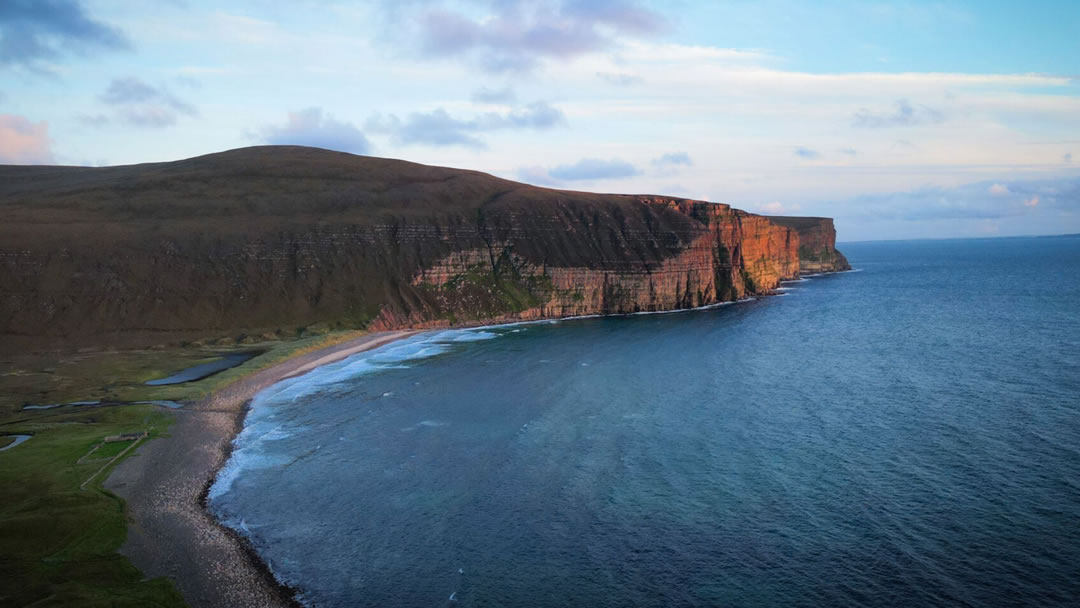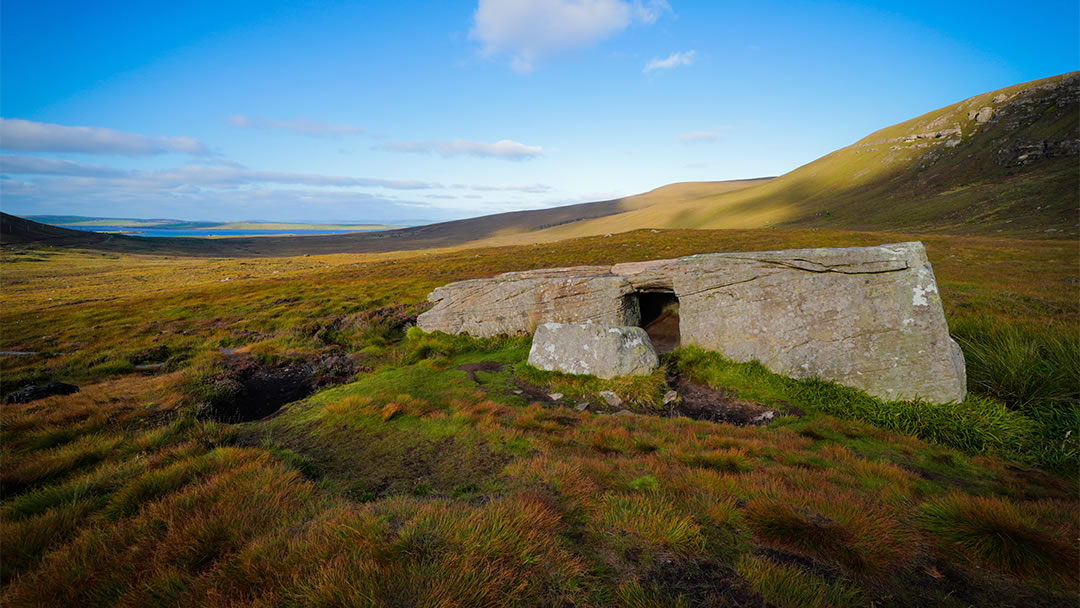A must visit on your Orkney Islands campervan trip: Rackwick Beach
Before I even set foot on the Orkney Islands to start my campervan adventure, my interest was piqued as I sailed from Scrabster on the northern coast of Scotland to Stromness on the Orkney Islands.
Rackwick Beach is the kind of place that leaves an indelible mark on your soul and makes you forget all your worries, if only for a while.
Passing by the Island of Hoy aboard NorthLink Ferries’ ship, I couldn’t help but notice the mountainous scenery, the Old Man of Hoy sea stack, and the towering St. John’s Head, which is the tallest vertical sea cliff in the UK. It was at this moment that I knew I had to explore the Island of Hoy.

After several days on the Orkney mainland, I found myself boarding the vehicle ferry in Houton, bound for Lyness on Hoy. Arriving in Lyness in the early evening, I set my sights on Rackwick Beach.

While travelling along the single-track road, I couldn’t help but notice a significant difference in the landscape compared to the Orkney mainland. To my left, the terrain was rugged, characterised by steep hills and heather, a sharp contrast to the predominantly flat and farmland-dominated scenery of the mainland. To my right, Scapa Flow gradually came into view, a place with deep connections to both World War I and II.

As I made the turn towards Rackwick beach, the breath-taking mountainous scenery reminded me of the Scottish Highlands.

The Island of Hoy felt like an isolated haven, unlike anywhere else I have visited in Scotland. I imagined the tranquil life in the cottages nestled among the hills.

Arriving at Rackwick Beach, I parked my van in the spacious free car park and followed the well-marked path, passing a public toilet and a camper van toilet disposal.

The ten-minute walk to the beach was flat and easy, and along the way, I encountered some friendly Highland Cows in a nearby field.

Just before the beach, I came across Burnmouth Bothy, a simple shelter offering free accommodation for travellers.

Bothies like these can be found across Scotland, often nestled in remote locations, and are accessible to all, usually left unlocked and available at no cost. I looked inside the bothy and met a group of cyclists enjoying the warmth of a crackling fire.

After checking out the bothy, I made my way down to the rocky Rackwick beach, where an incredible sight awaited. Towering cliffs framed both sides of the beach, with enormous waves crashing onto the rocky shore. The sound of the waves was deafening, and I could taste the salty sea spray in the air.

What makes this beach remarkable is its unique surface, primarily covered in smooth, rounded stones rather than the usual sandy shoreline. However, there is a small sandy section that can be discovered at the far end of the beach.

As the sun started to set, I struck up a conversation with the only other person on this vast beach – a man who had been visiting the area since the 1970s and was staying in one of the nearby cottages.

He shared tales of sunsets turning the cliffs bright red, advice on local walks, and stories of history and residents Rackwick has seen throughout the years. Aside from us two, the vast beach was deserted, amplifying the profound influence of nature and humans’ relatively modest place within it.

As the man made his way back to his cottage, I found myself in solitude on the beach. Seated upon a bench adjacent to the bothy, I gazed out at the setting sun, losing myself in contemplation. Few places in the world offer this kind of serenity – a place that draws you into the present, banishing all worries.

That night, I stayed in my campervan in the beach car park and had a wonderful night of sleep. The following day, I returned to Rackwick Beach.

It appeared entirely different in the morning light, with the sunlight coming from another direction.

I strolled along the path beside the beach, crossed a small river, and reached the sandy section. While sitting and taking in the views, I spotted the NorthLink ferry sailing past in the distance. It dawned on me that, had it not been for that ferry journey, I might never have discovered this enchanting island.

Leaving the beach was difficult; it was undeniably one of the most impressive places I have ever visited in Scotland. I resolved to return.
After returning to the car park, I embarked on the three-hour round-trip hike to the Old Man of Hoy, a sea stack located near Rackwick Beach.

The cliff-top path offered panoramic views of Rackwick Beach and the towering hills. The stunning scenery with clear skies and blue seas left me in awe.

The Old Man of Hoy, one of the UK’s tallest sea stacks, was a sight to behold up close, especially after having seen it from a distance on the NorthLink Ferry.

For the more adventurous, there is the option to continue on and complete a loop hike around the cliffs, though it would likely require a full day due to the distance.

I returned to Rackwick Beach car park and made my way back to Lyness. Along the route, I stopped at Dwarfie Stane, a remarkable Neolithic tomb which is over 5,000 years old. I also paid a visit to Betty Corrigall’s grave, considered one of the loneliest graves in the UK.
Lastly, I explored the Scapa Flow Museum, an incredible repository of information about Orkney’s role in both World War I and II. The museum, which has been nominated for awards, ranks among the best I have ever visited.

Rackwick Beach has undoubtedly been the highlight of my Scotland campervan adventures so far. I wholeheartedly recommend anyone visiting Orkney to make the effort to explore this incredible spot. It’s the kind of place that leaves an indelible mark on your soul and makes you forget all your worries, if only for a while.
 By Ruth Aisling
By Ruth AislingRuth Aisling is a Scottish content creator with a passion for adventure, campervan travel, and the great outdoors. You’ll often find her showcasing unique off-the-beaten-path destinations and inspiring others to explore. Discover more at www.instagram.com/ruthaisling
Pin it!
